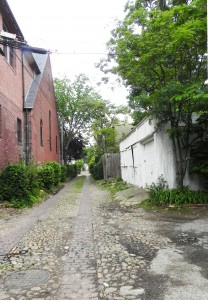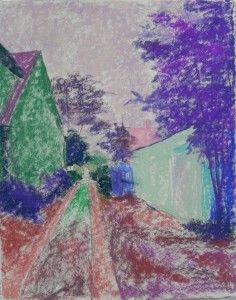I spent a couple hours at the studio today working on the underpainting for a new alley picture that I drew yesterday. While I was doing the underpainting, I thought about yesterday’s class with some new students and their questions about underpaintings–and all the questions I keep getting from my regulars! So I thought I’d do a post with just an underpainting and really focus the discussion on that. I took a photo before applying the alcohol, but unfortunately, got into a conversation and forgot to film it after the alcohol! But perhaps its easier to see the color choices and amounts of pastel applied from the un-alcoholed version anyway.
I’m giving you the original color photo as well, so you can see what I was working from. I also printed out a B&W version, which I found quite inspiring.
So first, about the photo. On Tues., I had a date to meet friends at the Library of Congress and left early to take photos of alleys. Unfortunately, it was an overcast day with no interesting light at all. But I found this alley, that I really liked and know that I’ll go back to. I liked this photo because of the richness of darks and lights and thought I could do something with it. I was thinking of making it into an 18 x 24 but it wouldn’t work. So I am now working on a 16 x 20 board of mounted UART 400.
The first concern that I often hear from students is: why spend time on the drawing and then lose it in the underpainting? This is a legitimate question, for sure. I spent a lot of time on the drawing yesterday and I didn’t stop until I was satisfied with the overall layout of the picture. Once I have the basic shapes where I want them, it doesn’t matter whether I lose some detail. And, over time, I’ve learned not to even draw in the detail to begin with. For instance, you’ll see that I haven’t added the windows into the church or any detail into the white garage. Also, my only concern with drawing in the foreground was the overall shapes of the brick vs. cobblestone areas and the lines. When I began, I focused first on the end of the alley and where that would be on the paper. I didn’t want it in the middle, and I wanted more space on the right and less on the left.
Once I’ve done the underpainting, I find it easier to see things that aren’t quite right and correct them. For instance, the roof on the garage is not steep enough, and I think the building needs more foreshortening. I can correct this easily with a hard pastel. I also don’t think that the church is quite right, but part of the problem with it is the angle of the photograph. However, I can draw over the completed underpainting, and do more underpainting, if I feel it’s necessary. Remember that pastel is a very forgiving medium!
Another advantage to doing the underpainting is that it allows me to begin rather intuitively and quickly, not worrying about perfection. Once I have color down, then I can focus on the level of perfection that I want to achieve.
Color choices. It was the color choices that I started thinking about while doing this. It’s the hardest thing for new people to grasp. I tell them that it doesn’t matter what color you use as long as you don’t begin too lightly. Having worked for over 20 years in pastel, I know that my color choices are very intuitive, based on experience and what appeals to me at the moment. In this picture, you’ll see a wide gamut of selections! So I thought I’d try to explain them. First, the sky, I used two pastels: a light violet and a lighter whitish orange. The sky is white in the photo and it was pretty gray when I took the photo. But i still see light there, and I think I’ll want to use a warm neutral of some sort (e.g., beige, cream) for the overcolor. So I decided to start with a cooler violet, that would also tie to the violets in the trees and shrubs. I could have used almost any color here, but I like working lighter over darker and warmer over cooler, so this should work. (I often use orange under a blue sky–warm under cool).
For the trees, I’ve used several values of violet and red violet. There is very little light on them and I didn’t want to get into the areas of light and dark in the large tree at right. So I kept them simple. I almost never use green under green, but I did use a little dark green in the bushes, and went with greens for the very small distant trees at the end of the alley. These are small details that are easier to see if the local color has been applied. For the brick building, I’ve used the complement: green under what will be red brick. This always works for me. For the white garage, I wanted something darker and cooler than what I’ll end up with. And adding the green to the building might help tie the two buildings together (in the underpainting at least!), given their differences. (I’m sure I went for the green because of the green on the left.)
I know that the foreground is going to be the real challenge in this picture. Unfortunately, I don’t have a textured, hand-made surface, which would make it easier. So I wanted to begin with some richer, darker color, over which I’ll apply neutral browns and grayed violets.
The underpainting, once the alcohol was applied is darker than what you are seeing and the shapes are quite well defined. Sorry I forgot the photo! But I hope that this will be helpful to some of you who are struggling to figure out why and how to do an underpainting and what colors to apply. I could have used a completely different palette and still come out with a successful painting, but I tend to go with the solutions that I know will work. For those new to this, it’s a matter of trial and error. Just remember to think value first, temperature second!
Doing underpaintings provides a chance to be a little free at the beginning before getting down to the more serious work! So enjoy it!!!
A happy Memorial Day weekend to you all.


